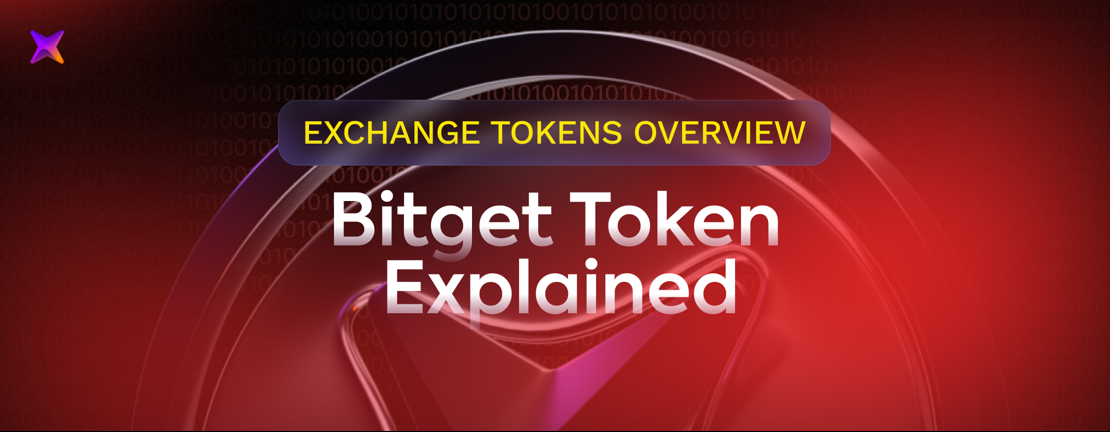Published 03 Sep 2025
Bitget Token (BGB): Exchange Token Powering the Bitget Ecosystem

As trading platforms compete for users worldwide, exchange tokens have become one of the most influential categories of assets. They started as simple loyalty tools — giving traders discounts on fees or access to special promotions — but have since evolved into major pillars of entire ecosystems. Today, tokens like Binance’s BNB and OKX’s OKB are not just ways to save on trading costs. They are multi-billion-dollar assets that connect centralized exchanges with broader Web3 applications, from staking and lending to Layer-1 and Layer-2 blockchains.
Bitget Token (BGB) is part of this same movement. Launched in 2021, it has quickly grown into one of the top exchange-based tokens by market capitalization. What makes BGB interesting is how Bitget uses it to link the exchange’s centralized services with its decentralized initiatives, including wallets and Layer-2 partnerships. In this way, BGB reflects a broader trend: exchange tokens are no longer limited to trading discounts. They are becoming gateways between millions of exchange users and the expanding world of DeFi.
What Is BGB and Why It Exists
Bitget Token (BGB) is the native asset of the Bitget exchange. It was introduced in 2021 as a replacement for the platform’s earlier token, BFT, with the goal of creating a stronger and more versatile foundation for the exchange’s growth. Unlike BFT, which had limited use, BGB was designed from the start to play a central role in Bitget’s ecosystem.
The main idea behind BGB is straightforward: connect the success of the exchange with the interests of its users. Holding BGB gives traders tangible advantages, such as lower fees and early access to new listings, while at the same time strengthening loyalty to the platform. For Bitget, the token works as both an incentive and a growth tool — the more people use it, the more demand builds around the exchange itself.
Over time, BGB’s role has expanded beyond fee reductions. Today it is a multi-purpose token that supports trading, rewards participation in community events, and opens doors to new opportunities within Bitget’s services. It reflects a wider industry trend where exchange tokens evolve into strategic assets, linking centralized platforms with emerging decentralized products.
Core Functions on the Exchange
On Bitget itself, BGB works as a key that unlocks a broad set of benefits. The most visible one is trading fee reduction. For active traders, even a small cut in fees can add up to significant savings over time, and Bitget positions BGB as the most cost-effective way to trade on its platform.
Another core function is access to new tokens. Through Bitget Launchpad and Launchpool, BGB holders can take part in early-stage projects before they reach the wider market. This turns BGB into more than a utility coin — it becomes a ticket to investment opportunities that are usually reserved for insiders or venture funds.
The token is also tied to VIP membership levels, which come with extra privileges such as higher withdrawal limits, better interest rates on Earn products, and exclusive promotions. By holding BGB, users can climb into higher tiers without relying only on trading volume, giving smaller traders a chance to enjoy premium benefits.
Bitget’s focus on social and copy trading also brings BGB into play. Traders who attract followers through copy trading can earn a share of profits, and BGB is part of the reward system that encourages this interaction. In this way, the token helps strengthen community dynamics, rewarding skilled traders while benefiting those who follow them.
In addition, Bitget runs campaigns and reward programs where BGB serves as the medium for lotteries, airdrops, or discounted group purchases of popular coins. These activities make the token present in daily exchange life, not just as a background feature but as an active part of the user experience.
Taken together, these functions show how BGB is woven into almost every corner of the exchange. It lowers costs, opens access to new assets, and builds a system where loyal users consistently find extra value.
BGB in the Ecosystem
Bitget designed BGB not just as an internal discount tool but as a token that extends across its wider ecosystem. This broader role is especially clear when looking at Bitget Wallet, the multi-chain wallet formerly known as BitKeep. Inside the wallet, BGB can be used to cover gas fees across multiple blockchains through a feature called GetGas. Instead of holding different native tokens for every chain, users top up BGB and use it as a universal fuel for transactions. This makes the wallet easier to use and gives BGB direct utility in daily on-chain activity.
Beyond the wallet, Bitget has linked BGB to various DeFi-style programs. Holders can lock their tokens in Launchpool or other staking campaigns to farm new project tokens. These opportunities place BGB in the same category as other yield-bearing assets, creating a bridge between exchange services and decentralized incentives.
The token’s role expanded further in 2025 with Bitget’s partnership with Morph, a Layer-2 network built on Ethereum. Under this collaboration, BGB is positioned to act as both the gas token for network transactions and the governance token for community decisions. This means that millions of Bitget users who already hold BGB could directly participate in a decentralized environment, from payments to voting on network upgrades.
BGB is also listed on other exchanges, which increases its liquidity and makes it more accessible outside of Bitget’s own platform. This market presence ensures that the token can circulate more freely, reinforcing its status as an asset with utility beyond a single exchange.
All of these developments show how BGB is evolving into a CeDeFi token — one that connects centralized services with decentralized applications. For Bitget, the strategy is clear: use BGB as the common thread linking the exchange, the wallet, and emerging blockchain ecosystems. For users, it means the token they hold for trading benefits can also serve as a tool for navigating the broader Web3 space.
Tokenomics Explained Simply
Every exchange token needs a clear economic model, and BGB is no exception. When it launched in 2021, the total supply was set at 2 billion tokens. Part of this supply went to replace the older Bitget token (BFT), while the rest was split between team incentives, marketing, user rewards, and ecosystem development. But what makes BGB stand out is how quickly Bitget adjusted its tokenomics to support long-term value.
The most important element is the burn mechanism. Bitget has committed to permanently removing large portions of the supply over time. In early 2025, the exchange burned 800 million tokens in a single move — wiping out 40% of the original supply and putting all remaining tokens into circulation. From that moment, there were no locked reserves waiting to be released, which gave holders confidence that supply inflation would not dilute their holdings.
Instead of relying only on one-time events, Bitget now ties its burns to real usage. The amount of BGB burned each quarter depends on how much the token is used across the ecosystem, for example as gas fees in Bitget Wallet. This model links supply reduction directly to activity: the more the ecosystem grows, the more tokens disappear from circulation. Over time, the target is to shrink the total supply from billions down to just 100 million BGB, creating a strong deflationary pressure.
For holders, BGB also works as an income-generating asset. Tokens can be staked in Launchpool or other promotional pools to earn new project coins. They can also be deposited into Bitget’s Earn products, where users collect interest on their holdings. In addition, BGB unlocks indirect value by cutting trading costs, granting VIP privileges, or giving access to exclusive airdrops. All these incentives combine to reward loyalty and encourage long-term holding.
Compared with other exchange tokens like BNB or OKB, BGB follows a similar path but with its own flavor. Like BNB, it uses large-scale burns to reduce supply, but unlike the early days of BNB, BGB has linked its deflation schedule to actual ecosystem activity. This approach makes the tokenomics more transparent and gives users a direct reason to care about the growth of Bitget’s products.
In simple terms, BGB’s tokenomics are built around two pillars: shrinking supply and steady rewards. One makes the token scarcer, the other makes it more useful to hold. Together they form the foundation for BGB’s role as the engine of Bitget’s ecosystem.
Market Performance and Growth
Since its launch, BGB has shown how an exchange token can evolve from a niche utility into a widely traded asset. At first, in 2021, it traded quietly as users swapped in their old BFT holdings. For much of that year and early 2022, BGB remained under the radar, priced only a few cents per token.
Momentum started to build in 2023. Bitget rolled out new services — especially Launchpad, Launchpool, and VIP programs — that gave BGB real utility beyond trading discounts. At the same time, the exchange gained visibility through global sponsorships and its reputation as a leading platform for copy trading. As more users joined, demand for BGB increased, and its price began climbing steadily.
By 2024, the token’s growth became impossible to ignore. Integration with Bitget Wallet gave it a role in on-chain transactions, and major marketing pushes highlighted it as a central part of the platform’s identity. Toward the end of that year, BGB reached all-time highs, briefly trading above several dollars per token. That performance put it in the same conversation as exchange heavyweights like Binance’s BNB and OKX’s OKB.
The turning point came with the massive supply burn in early 2025. By eliminating 40% of the total supply in one move, Bitget sent a clear signal: BGB would be managed with long-term scarcity in mind. Markets responded positively, seeing the burn as proof of commitment. Around the same time, the partnership with Morph Layer-2 gave BGB fresh momentum, as it gained a role beyond the exchange.
Today, BGB ranks among the top exchange tokens by market capitalization. It attracts attention not only from retail users who want lower fees and launch access, but also from larger investors looking for assets tied to platforms with strong growth. Its performance shows how a token closely tied to an exchange’s strategy can grow in value when that exchange successfully expands its ecosystem.
The Bigger Picture: Why BGB Matters
Exchange tokens are more than loyalty points. They represent the health, ambition, and long-term vision of the platforms behind them. In Bitget’s case, BGB has become the centerpiece of a strategy that blends centralized services with decentralized innovation.
For everyday users, BGB makes the exchange more affordable and more rewarding. Traders save money on fees, gain access to new listings, and can climb into VIP tiers that unlock privileges once reserved for institutional players. Casual users benefit too, since holding BGB gives them chances at airdrops, discounted token sales, and interest-earning opportunities. In short, the token directly improves the trading experience.
For Bitget as a company, BGB creates loyalty and a reason for users to stay within its ecosystem. When people hold the token, they are more likely to trade on Bitget, use the wallet, or participate in new launches. This builds a feedback loop: more activity drives more demand for BGB, which in turn strengthens the platform’s market position.
On the market level, BGB shows how second-generation exchange tokens are evolving. The first wave, led by BNB, proved that tokens could extend beyond trading discounts into payments, DeFi, and even entire blockchains. BGB follows that path but with its own approach, tying burns directly to real usage and extending utility into a Layer-2 network. This positions it as both a competitor to established tokens and a model for how newer exchanges can carve out space in the CeDeFi era.
The bigger picture is clear: BGB isn’t just a side feature of the Bitget platform. It is the glue connecting exchange activity, wallet transactions, and decentralized applications. With aggressive supply reduction, ongoing ecosystem integration, and a growing user base, it has become one of the most significant exchange tokens to watch. For investors, traders, and analysts alike, BGB illustrates how an exchange can turn its token into a strategic asset — and why the line between CeFi and DeFi is becoming harder to separate.
Read More




 Get RateX Pro
Get RateX Pro

 06 Jun 2024
06 Jun 2024
